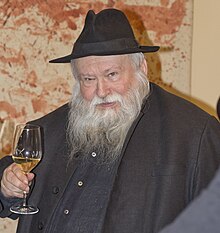Hermann Nitsch
Hermann Nitsch | |
|---|---|
 Nitsch in 2012 | |
| Born | August 29, 1938 Vienna, Austria |
| Nationality | Austrian |
| Education | Wiener Graphische Lehr-und Versuchanstalt |
| Known for | Performance art, music |
| Notable work | Orgien Mysterien Theater |
| Movement | Vienna Actionists |
| Website | www |
Hermann Nitsch (born 29 August 1938) is an Austrian avant-garde artist who works in experimental and multimedia modes.
Born in Vienna, Nitsch received training in painting when studied at the Wiener Graphische Lehr-und Versuchanstalt, during which time he was drawn to religious art.[1][2] He is associated with the Vienna Actionists—a loosely affiliated group of off-kilter and confrontational Austrian artists that also includes Günter Brus, Otto Muehl, and Rudolf Schwarzkogler.[3]
Nitsch's abstract 'splatter' paintings, like his performance pieces, are inspired by his neutral perspective on humanity and being human. In the 1950s, Nitsch conceived of the Orgien Mysterien Theater (which roughly translates as Theatre of Orgies and Mysteries or The Orgiastic Mystery Theater), staging nearly 100 performances between 1962 and 1998.[3]
In 1966 he was with Yoko Ono, Gustav Metzger, Otto Muehl, Wolf Vostell, Juan Hidalgo and others a participant of the Destruction in Art Symposium (DIAS) in London.[4]
Orgien Mysterien Theater
Nitsch's Orgien Mysterien Theater performances (or Aktionen, as he calls them) can be considered both ritualistic and existential. The scene is often involved with slaughters, religious sacrifices, crucifixion, as well as blood and flesh. The performances are also accompanied with music, dancing, and active participants. In his first Orgie Mysterien Theater performance, Nitsch and his friends used animal carcasses, entrails, and blood similarly to a ritual. The cloths, bandages and other fabrics used in these performances introduced Nitsch to the idea of making paintings.[3] Most recently, he has exhibited his works during the Venice Biennale 2017 at the European Cultural Centre.[5][6]
Controversial aspects
Having grown up during World War II, Nitsch reveals his fascination with the intensity of religious feelings for life in his art work with excessive means such as taboo images, nudity, bloody scenes and more. For this, he received several court trials, being charged with gross public indecency and sentenced to three prison terms. It is often suggested that his work may exemplify certain peoples' fascination with violence.[1][7][8][9]
References
- ^ a b Hermann Nitsch, Discogs.
- ^ Hermann Nitsch, Art Directory.
- ^ a b c HERMANN NITSCH, By Jonas Vogt, Alexander Nussbaumer.
- ^ Destruction in Art Symposium (DIAS), London, 1966.
- ^ "PERSONAL STRUCTURES - Cornerhouse Publications". Cornerhouse Publications. Retrieved 2017-07-11.
- ^ "Personal Structures". Lodown Magazine. 2015-04-13. Retrieved 2017-07-11.
- ^ Article in Italian newspaper La Repubblica
- ^ Sabbath, Bloody Sabbath: The Sacrificial Rites of Hermann Nitsch. Archived 2013-06-01 at the Wayback Machine
- ^ Animals, art and death: a note on Hermann Nitsch's 3-Day-Play.
Sources
- Stark, Ekkehard. Hermann Nitschs 'Orgien Mysterien Theater' und die "Hysterie der Griechen." Quellen und Traditionen in Wiener Atikedild seit 1900
- Winkler, Michael. Review: Hermann Nitschs 'Orgien Mysterien Theater' und die "Hysterie der Griechen." Quellen und Traditionen in Wiener Atikedild seit 1900 by Ekkehard Stark. The German Quarterly, Vol. 61, No. 4, 60th Anniversary 1928-1988 (Autumn, 1988) pp. 590–591.
- Romberg, Osvaldo. Redemption through Blood:pp. 8–13, 60-71
External links
- UbuWeb Films Hermann Nitsch (b. 1938)
- Hermann Nitsch's Homepage (in German)
- „Hermann Nitsch“ on SAST REPORT Culture
- Video of Hermann Nitsch in America
- The Saatchi Gallery - Hermann Nitsch, Gallery In London with images, information, text and biography about Hermann Nitsch
- Hermann Nitsch - The Movie, HN The Movie - a documentary film about Hermann Nitsch
- Nitschland Napoli Film by Roberto Paci Dalò
- Museo Hermann Nitsch
- 64. Malaktion Mart Rovereto Italy 02-06/10/2012 by Alain Chivilò
- Symphony in Beef Major, enthusiastic review of Nitsch's Island CD box set by Kyle Gann, The Village Voice (1998).
